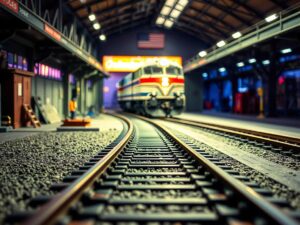
Programming DCC Decoders HO Scale
Step-by-Step Guide to Programming DCC Decoders for HO Scale
Hey fellow railfans! Welcome back to the blog. Today, we’re diving into a topic that can be both intimidating and exciting, programming DCC decoders in your HO scale model trains.
Before you run off thinking it’s some arcane sorcery reserved for computer whizzes, take a breath! DCC (Digital Command Control) opens up a world of possibilities, letting you control individual locomotives with incredible precision and detail. And the good news? Programming DCC decoders in HO scale is more accessible than you might think!
Understanding the Basics: DCC Decoders Explained
Imagine your model locomotive like a miniature racecar, powered by electricity. That electrical current needs to be controlled, regulated, and directed to make your engine chug, stop, switch directions, and sound realistic. This is where DCC decoders come in!
A decoder is essentially an onboard computer for your locomotive, converting the digital signals sent from your DCC controller (think of it as the pit crew) into instructions that your train understands. It allows you to control speed, direction, lights, sound, and even create customized “sound profiles” for different locomotives.
Choosing the Right Decoder for Your HO Scale Needs
There are tons of amazing DCC decoders out there designed specifically for HO scale models. The most important factors to consider when choosing a decoder are:
- Power Consumption: Look at your locomotive’s specifications and choose a decoder that matches its power requirements.
- Features: Do you want basic speed and direction control, or fancy sound effects and smoke outputs? Choose a decoder with the features you need for your setup.
- Sound Capability: If sound is important to you, consider decoders from reputable brands known for their realistic locomotive sounds.
The Art of Decoder Installation: A Hands-On Approach
Let’s be real, sometimes getting your hands dirty can be the most rewarding part of model railroading! Installing a decoder into an HO scale locomotive usually involves:
-
Opening Up: Carefully disassemble your locomotive, taking notes or pictures along the way to make reassembly easier later. You’ll need access to the motor and wiring harness.
-
Harness Connection: Connect the decoder’s wires to your locomotive’s motor and light connections according to the manufacturer’s instructions (each decoder is unique). A good soldering iron and solder are essential tools here for secure, long-lasting connections.
-
Secure Placement: Gently slide the decoder into a designated spot inside the locomotive frame, making sure it’s secure and won’t interfere with movement. You may need to modify or create supports depending on the space available.
- Reassembly & Testing: Put your locomotive back together, test each function carefully (motor rotation, lights), and adjust wiring if necessary.
Remember: Patience is key! If you’re a newbie, don’t hesitate to watch online tutorials specifically for installing decoders in your particular model. You’ll be surprised how easy it can become.
The Moment of Truth: Programming Your Decoder
This is where the magic happens! Using your DCC programmer (either handheld or software-based), you send specific digital instructions to your decoder, customizing its behavior. Here’s a simplified breakdown:
- Setup: Plug in your DCC system, ensure it’s operational, and connect your locomotive with the decoder installed.
-
Addressing Your Decoder: Each DCC device needs a unique address. This identifies your locomotive within the entire DCC network. Program the correct address into your decoder using the programmer’s interface. Think of this as giving your train a digital “identity card.”
-
Configuring Parameters:
Now comes the fun part! Depending on your chosen decoder, you can program various settings:
* Starting Speed and Acceleration: Set how quickly your locomotive picks up speed from zero.
* Maximum Speed: Limit the top speed for safety and realistic performance.
* Brake Settings: Configure braking strength and behavior for smooth stops.
-
Adding Sounds (If Equipped): Most sound-equipped decoders allow you to choose specific engine sounds, horn blasts, bells, and even effects like air compressors. Spend some time finding the perfect combination for your chosen locomotive!
-
Save Your Progress: Ensure that your program changes are saved to the decoder’s memory for permanent operation.
Programming DCC Decoders: Advanced Tips
- Keep Notes!: As you learn and modify, jot down all settings used on each decoder. This becomes a valuable reference library over time.
-
Step-by-Step Guides: Refer to your chosen decoder’s manual! While this article provides general guidance, manufacturers often have detailed guides for specific programming functions and troubleshooting tips.
-
Practice Makes Perfect: Donât get discouraged if it takes some time to master the art of DCC programming. The more you practice, the more comfortable and confident you’ll become.
The Journey Has Just Begun
Congratulations! You’ve taken your first steps into the exciting world of DCC programming for HO scale trains. The possibilities are truly endless. Imagine running multiple locomotives simultaneously, each with its unique characteristics, sound effects, and lighting, all orchestrated from your controller!
Now go forth, program those decoders, and build a digital rail network that will astound you (and perhaps a few fellow modelers)!
Stay tuned for more in-depth articles on specific DCC brands, programming techniques, and advanced project ideas. We’re here to help you every step of the way. And don’t hesitate to share your experiences, questions, or tips in the comments below! Let’s build a fantastic community of HO scale enthusiasts together.








